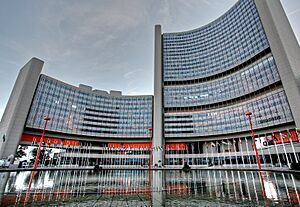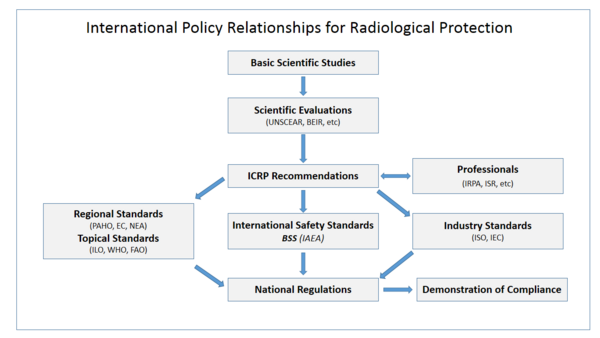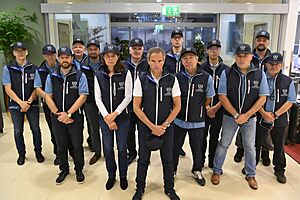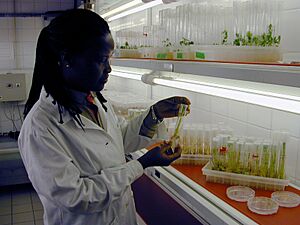International Atomic Energy Agency facts for kids
Quick facts for kids  International Atomic Energy Agency |
|
|---|---|
| Org type | International organization |
| Status | Active |
| Headquarters | Vienna, Austria |
The International Atomic Energy Agency (IAEA) is a special group that works with the United Nations. It was created in 1957. Its main goal is to make sure that nuclear energy is used only for peaceful things, like making electricity or helping in medicine. It also works to stop countries from using nuclear energy to make nuclear weapons. The IAEA's main office is in Vienna, Austria.
The IAEA was started because many countries were worried about nuclear weapons, especially during the Cold War. At that time, the United States and the Soviet Union had many nuclear weapons. U.S. President Dwight D. Eisenhower gave a speech called "Atoms for Peace". He suggested creating an international group to watch over nuclear materials and technology around the world. This idea helped lead to the creation of the IAEA.
The IAEA helps countries share knowledge and work together on peaceful uses of nuclear technology. It has programs that:
- Encourage the development of peaceful uses for nuclear energy, science, and technology.
- Check that nuclear technology and materials are not used for military purposes (these are called "safeguards").
- Promote and set high standards for nuclear safety (which includes protecting people from radiation).
- Do research in nuclear science and offer training to countries, especially developing ones.
After the Treaty on the Non-Proliferation of Nuclear Weapons was signed in 1968, countries that don't have nuclear weapons must agree to let the IAEA check their nuclear programs. In 2005, the IAEA and its leader at the time, Director General Mohamed ElBaradei, won the Nobel Peace Prize. They received it for their work in preventing nuclear energy from being used for military reasons and making sure it's used safely for peaceful purposes.
Contents
What the IAEA Does: Its Main Missions
The IAEA has three main jobs or missions:
- Peaceful Uses: Helping its member countries use nuclear energy for good things.
- Safeguards: Checking to make sure nuclear energy is not used to build weapons.
- Nuclear Safety: Encouraging high standards for nuclear safety around the world.
Promoting Peaceful Uses of Nuclear Energy
The IAEA's rules say its goals are to "speed up and increase the help that atomic energy gives to peace, health, and wealth worldwide." It also aims to make sure that any help it gives is not used for military purposes. To do this, the IAEA encourages research, provides materials and equipment to member countries, and helps share scientific and technical information and training.
Three of the IAEA's six departments focus on promoting peaceful uses of nuclear energy:
- The Department of Nuclear Energy gives advice and services on nuclear power and how nuclear fuel is used.
- The Department of Nuclear Sciences and Applications helps countries use nuclear and isotope techniques for things like water, energy, health, and agriculture.
- The Department of Technical Cooperation directly helps member countries through projects, training, expert visits, and providing equipment.
Ensuring Nuclear Safeguards
One of the IAEA's main goals is to make sure that nuclear materials and technology are not used for military purposes. The IAEA is allowed to set up and manage "safeguards." These safeguards are checks to make sure that special nuclear materials, equipment, and information are not used to make weapons. The IAEA can also apply these checks if countries ask for them.
The Department of Safeguards is in charge of this mission. They use technical methods to check that countries are telling the truth about their nuclear programs.
Improving Nuclear Safety
The IAEA sees safety as one of its top three priorities. It spends a lot of its budget on making nuclear plants safe from accidents. Its resources are also used for technical help and stopping the spread of nuclear weapons.
The IAEA greatly increased its efforts in nuclear safety after the nuclear reactor explosion near Chernobyl, Ukraine, in 1986. The same happened after the Fukushima disaster in Japan in 2011.
In 2011, the IAEA's chief received wide support for his plan to make international safety checks on nuclear power plants stronger. This was to help prevent another crisis like Fukushima. The IAEA has suggested that experts should regularly check reactors worldwide.
A Brief History of the IAEA
In 1953, U.S. President Dwight D. Eisenhower suggested creating an international group to both control and promote the peaceful use of nuclear power. This idea was part of his "Atoms for Peace" speech at the UN General Assembly. In 1954, the United States proposed creating an agency to manage nuclear materials.
It became clear that the Soviet Union would not agree to international control of nuclear materials unless the U.S. agreed to disarm first. However, a "clearinghouse" for nuclear dealings seemed possible. From August 8 to 20, 1955, the United Nations held a conference in Geneva, Switzerland, on the peaceful uses of atomic energy. The founding document for the IAEA was negotiated by twelve countries between 1955 and 1957. The IAEA's rules were approved on October 23, 1956, and officially started on July 29, 1957.
Former U.S. Congressman W. Sterling Cole was the IAEA's first Director-General from 1957 to 1961. After him, two Swedes led the IAEA for almost 40 years: Sigvard Eklund (1961-1981) and Hans Blix (1981-1997). Blix was followed by Mohamed ElBaradei of Egypt, who served until November 2009.
As mentioned, the IAEA increased its focus on nuclear safety after the 1986 Chernobyl disaster and again after the 2011 Fukushima disaster.
Both the IAEA and its Director General, ElBaradei, won the Nobel Peace Prize in 2005. In his speech, ElBaradei said that if we want to avoid destroying ourselves, nuclear weapons should not exist.
On July 2, 2009, Yukiya Amano of Japan was chosen as the next Director General. He started his job on December 1, 2009. After Amano's death, Cornel Feruta of Romania became the acting Director General.
On October 28, 2019, Rafael Grossi of Argentina was elected as the new Director General. He started his role on December 3, 2019, becoming the first person from Latin America to lead the Agency.
During the Russian invasion of Ukraine, Grossi visited Ukraine many times. He worked to help prevent a nuclear accident during the war. He warned about the dangers facing the Zaporizhzhia Nuclear Power Plant, which is Europe's largest nuclear power plant and has been under attack during the war.
How the IAEA is Organized and Works
The IAEA's work is guided by what its member countries need, its plans, and its founding rules. Its mission is built on three main areas: Safety and Security, Science and Technology, and Safeguards and Verification.
Even though the IAEA is an independent organization, it reports to both the UN General Assembly and the UN Security Council. The IAEA's structure and jobs are set out in its founding document, the IAEA Statute. The IAEA has three main parts: the Board of Governors, the General Conference, and the Secretariat.
The IAEA works to ensure the "safe, secure and peaceful uses of nuclear sciences and technology." It does this by:
- Inspecting nuclear facilities to make sure they are used peacefully.
- Providing information and setting standards for nuclear safety and security.
- Acting as a center for sharing knowledge in different fields of science that use nuclear technology peacefully.
The IAEA knows that knowledge is very important for the nuclear energy industry to work safely. Since 2002, it has had a program called "Nuclear Knowledge Management" to help member countries with this.
In 2004, the IAEA started a program called PACT (Programme of Action for Cancer Therapy). PACT helps developing countries set up or improve cancer treatment programs using radiation. The IAEA raises money to help its member countries save lives and reduce suffering from cancer.
The IAEA also has programs to help developing countries plan how to build a nuclear power program. About 60 countries are thinking about using nuclear power for their energy needs.
To help countries share information about the safety of nuclear facilities during earthquakes, the IAEA created the International Seismic Safety Centre in 2008. This center sets safety standards and helps apply them for choosing sites and designing nuclear facilities.
The IAEA's main office is in Vienna, Austria. It also has two "Regional Safeguards Offices" in Toronto, Canada, and Tokyo, Japan. There are also two liaison offices in New York City, United States, and Geneva, Switzerland. In addition, the IAEA has laboratories and research centers in Seibersdorf, Austria, Monaco, and Trieste, Italy.
The Board of Governors
The Board of Governors is one of the two main decision-making bodies of the IAEA. It has 22 member countries chosen by the General Conference. It also has at least 10 member countries chosen by the outgoing Board. These 10 are usually the most advanced in nuclear energy technology.
The Board meets five times a year. It is responsible for making most of the IAEA's policies. The Board suggests actions and budgets to the General Conference. It also publishes IAEA standards and chooses the Director-General, who then needs approval from the General Conference.
The General Conference
The General Conference includes all 178 member countries. It meets once a year, usually in September. Its job is to approve the actions and budgets suggested by the Board of Governors. The General Conference also approves the person chosen to be Director General.
The main purpose of the General Conference is to be a place where current issues and policies can be discussed. Any part of the IAEA, like the Director-General, the Board, or member countries, can bring up topics for the General Conference to discuss. This is similar to how the UN General Assembly works.
The Secretariat
The Secretariat is made up of all the professional and general staff who work for the IAEA. The Director General leads the Secretariat. The Director General is responsible for carrying out the decisions made by the Board of Governors and the General Conference. The Director General is chosen by the Board and approved by the General Conference for four-year terms.
The Director General oversees six departments that do the actual work of the IAEA: Nuclear Energy, Nuclear Safety and Security, Nuclear Sciences and Applications, Safeguards, Technical Cooperation, and Management.
The IAEA's budget has two parts. The regular budget pays for most of the IAEA's activities. Each member country pays a part of this budget. There is also a Technical Cooperation Fund, which is paid for by voluntary donations from countries.
Who are the Members?
Joining the IAEA is quite simple. A country tells the Director General it wants to join. The Director General then sends the request to the Board for review. If the Board approves, and the General Conference agrees, the country must officially accept the IAEA Statute. The country becomes a member when its acceptance letter is received by the United States, which holds the official copies of the IAEA Statute. Being a member of the IAEA does not require a country to have signed the Nuclear Non-Proliferation Treaty.
The IAEA has 178 member countries. Most countries that are members of the United Nations are also members of the IAEA, along with the Holy See.
Four countries have left the IAEA in the past. North Korea was a member from 1974 to 1994 but left after the IAEA found it was not following its safeguard agreements. Nicaragua joined in 1957, left in 1970, and rejoined in 1977. Honduras joined in 1957, left in 1967, and rejoined in 2003. Cambodia joined in 1958, left in 2003, and rejoined in 2009.
Regional Cooperation Agreements
The IAEA has four regional groups where countries share information and organize meetings:
AFRA: African Regional Cooperative Agreement
This group focuses on nuclear science and technology in Africa.
 Algeria
Algeria Chad
Chad Kenya
Kenya Morocco
Morocco South Africa
South Africa Angola
Angola Côte d'Ivoire
Côte d'Ivoire Lesotho
Lesotho Mozambique
Mozambique Sudan
Sudan Benin
Benin Democratic Republic of the Congo
Democratic Republic of the Congo Libya
Libya Namibia
Namibia Tanzania
Tanzania Botswana
Botswana Egypt
Egypt Madagascar
Madagascar Niger
Niger Tunisia
Tunisia Burkina Faso
Burkina Faso Eritrea
Eritrea Malawi
Malawi Nigeria
Nigeria Uganda
Uganda Burundi
Burundi Ethiopia
Ethiopia Mali
Mali Senegal
Senegal Zambia
Zambia Cameroon
Cameroon Gabon
Gabon Mauritania
Mauritania Seychelles
Seychelles Zimbabwe
Zimbabwe Central African Republic
Central African Republic Ghana
Ghana Mauritius
Mauritius Sierra Leone
Sierra Leone
ARASIA: Arab States in Asia Cooperative Agreement
This group works on nuclear science and technology for Arab states in Asia.
RCA: Asia and the Pacific Cooperative Agreement
This group focuses on nuclear science and technology for Asia and the Pacific.
 Australia
Australia Bangladesh
Bangladesh Cambodia
Cambodia China
China Fiji
Fiji India
India Indonesia
Indonesia Japan
Japan South Korea
South Korea Laos
Laos Malaysia
Malaysia Mongolia
Mongolia Myanmar
Myanmar Nepal
Nepal New Zealand
New Zealand Pakistan
Pakistan Palau
Palau Philippines
Philippines Singapore
Singapore Sri Lanka
Sri Lanka Thailand
Thailand Vietnam
Vietnam
ARCAL: Latin America and the Caribbean Cooperative Agreement
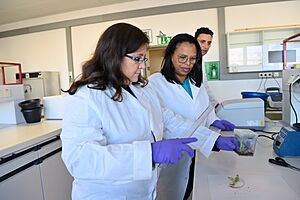
This group promotes nuclear science and technology in Latin America and the Caribbean.
 Argentina
Argentina Bolivia
Bolivia Brazil
Brazil Chile
Chile Colombia
Colombia Costa Rica
Costa Rica Cuba
Cuba Ecuador
Ecuador El Salvador
El Salvador Guatemala
Guatemala Haiti
Haiti Honduras
Honduras Jamaica
Jamaica Mexico
Mexico Nicaragua
Nicaragua Panama
Panama Paraguay
Paraguay Peru
Peru Dominican Republic
Dominican Republic Uruguay
Uruguay Venezuela
Venezuela
Leaders of the IAEA: Directors General
| Name | Nationality | Time in Office | Years in Office |
|---|---|---|---|
| W. Sterling Cole | December 1, 1957 – November 30, 1961 | 4 | |
| Sigvard Eklund | December 1, 1961 – November 30, 1981 | 20 | |
| Hans Blix | December 1, 1981 – November 30, 1997 | 16 | |
| Mohamed ElBaradei | December 1, 1997 – November 30, 2009 | 12 | |
| Yukiya Amano | December 1, 2009 – July 18, 2019 | 9 | |
| Cornel Feruță (Acting) | July 25, 2019 – December 2, 2019 | Less than 1 | |
| Rafael Grossi | December 3, 2019 – present | 6 |
See also
 In Spanish: Organismo Internacional de Energía Atómica para niños
In Spanish: Organismo Internacional de Energía Atómica para niños
- European Organization for Nuclear Research
- Global Initiative to Combat Nuclear Terrorism
- International Energy Agency
- International Renewable Energy Agency
- Lists of nuclear disasters and radioactive incidents
- List of states with nuclear weapons
- Nuclear Energy Agency
- United Nations Atomic Energy Commission (UNAEC)
- World Nuclear Association


